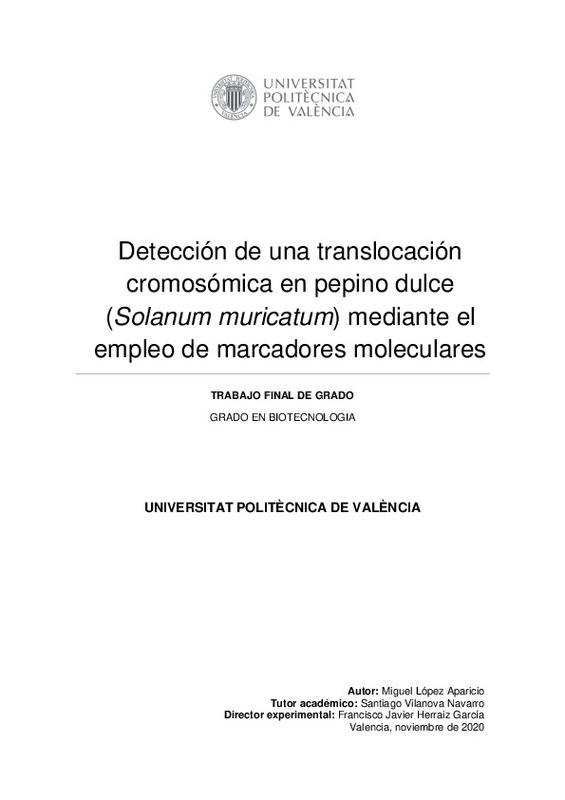JavaScript is disabled for your browser. Some features of this site may not work without it.
Buscar en RiuNet
Listar
Mi cuenta
Estadísticas
Ayuda RiuNet
Admin. UPV
Detección de una translocación cromosómica en pepino dulce (Solanum muricatum) mediante el empleo de marcadores moleculares
Mostrar el registro sencillo del ítem
Ficheros en el ítem
| dc.contributor.advisor | Vilanova Navarro, Santiago
|
es_ES |
| dc.contributor.advisor | Herraiz García, Francisco Javier
|
es_ES |
| dc.contributor.author | López Aparicio, Miguel
|
es_ES |
| dc.date.accessioned | 2020-12-28T11:56:00Z | |
| dc.date.available | 2020-12-28T11:56:00Z | |
| dc.date.created | 2020-12-09 | |
| dc.date.issued | 2020-12-28 | es_ES |
| dc.identifier.uri | http://hdl.handle.net/10251/157864 | |
| dc.description.abstract | [ES] El pepino dulce (Solanum muricatum) es un cultivo de procedencia andina cultivado por sus frutos, los cuales son apreciados por su sabor dulce, su aroma, así como por sus propiedades bioactivas (Herraiz et al., 2016b). Aunque filogenéticamente es una especie muy cercana tanto al tomate como a la patata, no ha sido tan estudiada a nivel genómico debido a su menor importancia económica. En este sentido, el grupo de mejora genética de solanáceas del COMAV, entre otros trabajos, llevó a cabo la secuenciación del transcriptoma de pepino dulce (Herraiz et al., 2016a) y un mapa genético de alta resolución mediante 1625 marcadores SNP obtenidos por GBS (Enshire et al., 2011). Este mapa genético determinó la presencia de 12 grupos de ligamiento, y su comparación con genomas de otras especies próximas sacó a la luz varias anomalías cromosómicas. Una de estas anomalías es una translocación no presente en ninguna otra solanácea, la cual requería de su confirmación. Este es el objetivo del presente trabajo final de grado. Para ello se sembraron semillas obtenidas por autofecundación de una variedad de pepino dulce con el fin de obtener una población de plantas de las que se extrajo ADN. A partir de secuencias del transcriptoma, se seleccionaron varios marcadores SNPs situados en los fragmentos implicados en la translocación. Estos marcadores fueron seleccionados con la condición de ser heterocigotos en pepino dulce. El estudio de la segregación de dichos marcadores y su frecuencia de recombinación o transmisión independiente nos permitirá confirmar o descartar la presencia de dicha translocación en el genoma de esta especie. Para ello se realizó un ensayo HRM (Li et al., 2010) cuyos resultados fueron analizados en un estudio de ligamiento genético. | es_ES |
| dc.description.abstract | [EN] The sweet cucumber (Solanum muricatum) is a crop of Andean origin grown for its fruits, which are appreciated for their sweet taste, aroma, as well as for their bioactive properties (Herraiz et al., 2016b). Although phylogenetically it is a species very close to both tomato and potato, it has not been as well studied at the genomic level due to its lesser economic importance. In this sense, the Solanaceae genetic improvement group of COMAV, among other works, carried out the sequencing of the sweet cucumber transcriptome (Herraiz et al., 2016a) and a high-resolution genetic map using 1625 SNP markers obtained by GBS. (Enshire et al., 2011). This genetic map determined the presence of 12 linkage groups, and its comparison with genomes of other nearby species brought to light several chromosomal abnormalities. One of these anomalies is a translocation not present in any other nightshade, which required its confirmation. This is the objective of this final degree project. For this, seeds obtained by self-fertilization of a variety of sweet cucumber were sown in order to obtain a population of plants from which DNA was extracted. From transcriptome sequences, several SNP markers located in the fragments involved in the translocation were selected. These markers were selected with the condition of being heterozygous in sweet cucumber. The study of the segregation of these markers and their frequency of recombination or independent transmission will allow us to confirm or rule out the presence of these translocation in the genome of this species. For this, an HRM trial was carried out (Li et al., 2010) whose results were analyzed in a genetic linkage study. | es_ES |
| dc.format.extent | 28 | es_ES |
| dc.language | Español | es_ES |
| dc.publisher | Universitat Politècnica de València | es_ES |
| dc.rights | Reconocimiento - No comercial (by-nc) | es_ES |
| dc.subject | Mapas genéticos | es_ES |
| dc.subject | Pepino dulce | es_ES |
| dc.subject | Solanum muricatum | es_ES |
| dc.subject | HRM | es_ES |
| dc.subject | SNPs | es_ES |
| dc.subject | Translocación | es_ES |
| dc.subject | Genetic maps | es_ES |
| dc.subject | Sweet cucumber | es_ES |
| dc.subject | Translocation | es_ES |
| dc.subject.classification | GENETICA | es_ES |
| dc.subject.other | Grado en Biotecnología-Grau en Biotecnologia | es_ES |
| dc.title | Detección de una translocación cromosómica en pepino dulce (Solanum muricatum) mediante el empleo de marcadores moleculares | es_ES |
| dc.type | Proyecto/Trabajo fin de carrera/grado | es_ES |
| dc.rights.accessRights | Abierto | es_ES |
| dc.contributor.affiliation | Universitat Politècnica de València. Departamento de Biotecnología - Departament de Biotecnologia | es_ES |
| dc.contributor.affiliation | Universitat Politècnica de València. Escuela Técnica Superior de Ingeniería Agronómica y del Medio Natural - Escola Tècnica Superior d'Enginyeria Agronòmica i del Medi Natural | es_ES |
| dc.description.bibliographicCitation | López Aparicio, M. (2020). Detección de una translocación cromosómica en pepino dulce (Solanum muricatum) mediante el empleo de marcadores moleculares. Universitat Politècnica de València. http://hdl.handle.net/10251/157864 | es_ES |
| dc.description.accrualMethod | TFGM | es_ES |
| dc.relation.pasarela | TFGM\112918 | es_ES |
Este ítem aparece en la(s) siguiente(s) colección(ones)
-
ETSIAMN - Trabajos académicos [3541]
Escuela Técnica Superior de Ingeniería Agronómica y del Medio Natural





![ZIP archive [ZIP]](/themes/UPV/images/zip.png)

